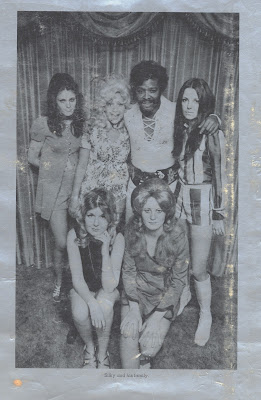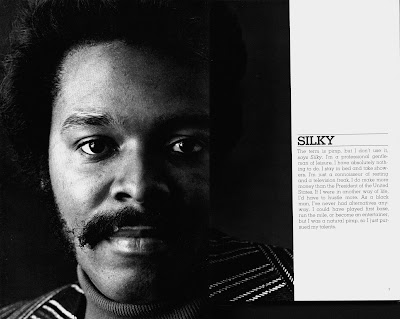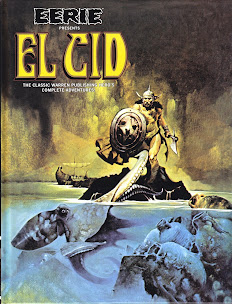Friday, February 3, 2023
Book Review: Gentleman of Leisure: A Year in the Life of A Pimp
Celebrating Black History Month 2023
Book Review: 'Gentleman of Leisure'
by Susan Hall and Bob Adelman
New American Library, 1972
Here at the PorPor Books Blog, we celebrate Black History Month by reading and reviewing nonfiction and fiction books that illuminate the black experience. We try to focus on books that are less well-known, and have lapsed into undeserved obscurity.
Robert Melvin Adelman (1930 – 2016) was a photojournalist who was best known for documenting the civil rights movement of the 1960s. He later expanded his coverage to professional sports and urban living, publishing photoessays on those subjects.
Coauthor Susan Hall, a filmmaker and author, is alive and well. Her books include 'On and Off the Street' (1970), 'Ladies of the Night' (1973) (which also deals with the urban demimonde) and 'Down Home, Camden, Alabama' (1974).
A 2017 interview with Bob Adelman, conducted shortly before his death, is available at the Rialto Report. The interview revealed that 'Silky', the star of the book, was still alive and hustling at that time.
'Gentleman' is a photoessay that deals with the day-to-day life of Silky, and some of the girls in his stable: Sandy, Kitty, Linda, Tracey, and Lois. The book intersperses its sections of photographs with text interviews with Silky, his fellow pimps, and the girls.
We learn that Silky prefers to have white women in his stable because black women have too much drama, and are less pliable.
Silky is of course delighted to be the subject of attention and the book presents his philosophies regarding hustling, pimping, and life in general.
Playing a major role in the pursuit of The Game are its physical accoutrements: the latest and flyest clothing, and the finest of rides. A pimp who does not Represent in style is on the downward curve.
Contrary to the usual trope of pimps keeping order in their stable through the direct application of force, Silky relies on financial rewards, and displays of affection, to persuade his girls to work for him. It seems that there is no shortage of women willing to take up prostitution; indeed, Silky is constantly cycling girls into and out of his stable and bemoans the effort required to tend to so many 'employees'.
The girls are enigmatic. It's not clear how much of what they tell Susan Hall is honest and forthright, but at least superficially, they have no regrets about their choice of profession and their reliance on Silky. It's the girls that offer observations on events carefully withheld by Silky; for example, we learn from them that he was serious injured in a fight with a rival pimp, to the extent of needing plastic surgery.
'Gentlemen' closes with a Glossary, a vital source of information for anyone contemplating writing a novel or screenplay dealing with the street scene in New York City in the early 1970s:
'Gentleman' is an interesting look at an urban subculture in its heyday in the 1970s, a subculture mythologized in the novels of Iceberg Slim and referenced by modern-day rappers like Snoop Dogg. Understandably, because they wanted access to Silky and his stable, Hall and Adelman carefully avoid passing judgment on the pimping enterprise, and covering its more unsavory aspects. And no doubt, Silky and the girls presented themselves in the best possible light to Hall and Adelman. These aspects of the interaction between chroniclers and subject will of course need to be held in mind while perusing the pages of 'Gentleman'.
Copies of the book, in good condition, can be had for under $20. But if you are interested in obtaining a copy, I would act sooner, rather than later, as the price for even a marginal copy inevitably is going to rise.
Labels:
Gentleman of Leisure
Thursday, February 2, 2023
Mickey Rat
Mickey Rat
by Robert Armstrong
from Mickey Rat, No. 3 (1980)
The horror of coming home from vacation to find that, in your absence, you've had a most unwanted visitor..........
Labels:
Mickey Rat
Tuesday, January 31, 2023
Alternative Comics in 1970s New York City
'A Personal Journey Through the World of Alternative Comics in 1970s New York City'
by Michael Gonzalez
Michael Gonzalez was 13 years old when, in 1977, he bought his very first issue of Heavy Metal magazine, an action that, over the ensuing two years, inspired him to try and publish his own sci-fi comic magazine. Gonzalez touched base with many of the comic world's illuminaries in his journey (he even telephoned and talked with Leonard Mogel !).
A great reminiscence of an important era in American comics and graphic art. Even though some of the art stars Gonzalez dealt with were pricks...........!
(link to CrimeReads courtesy of the 'We Are the Mutants' Twitter feed)
Saturday, January 28, 2023
Book Review: Berserker's Planet
Book Review: 'Berserker's Planet' by Fred Saberhagen
2 / 5 Stars'Berserker's Planet' (173 pp.) is DAW Book No. 147 and was published in April, 1975. The cover illustration is by Jack Gaughan.
This is one of a substantial body of novels and short stories that made up Saberhagen's very successful 'Berserkers' franchise, which began in 1967 with the eponymous novel. Additional books in the series were published well into the new century, with 'Rogue Berserker' released in 2005, just two years prior to Saberhagen's demise.
'Berserker Planet' consists of two narratives that eventually coalesce. In one narrative, a space ship, the Orion, whose passengers are three men and three women, all of them thrill-seekers in one sense or another, makes landfall on the planet Hunter. There the male passengers are to engage in hunting the native wildlife, an exercise by which they hope to inflate their machismo, and thus enjoy the favors of the women, who are to play the role both of cheerleaders and concubines.
The space ship is piloted by the wealthy and very self-assured Oscar Schoenberg. Carlos Suomi, a business acquaintance of Schoenberg, is the one hunt participant who has misgivings about its purpose, a stance which does not elevate him in the eyes of Schoenberg.
The other narrative deals with a uniquely brutal competition being held by the priestly caste of Hunter's mountaintop Holy City, Godsmountain. Sixty-four men, originating from the various districts of the planet, have been invited to participate in a tournament involving edged weapons. The one-on-one matches are to the death, and with each succeeding round, the combat arena moves closer to the summit of Godsmountain, where, the contestants are assured, the solitary victor will sit beside Thorun, the God of the Warriors, in a kind of Hunterian version of Valhalla.
The contestants, all fighting men with what could charitably be called limited educational backgrounds, eagerly risk death in the hopes of gaining their empyrean reward. Early in the tournament, the crew of the Orion arrives at the site and its passengers are intrigued, and excited, to witness the spectacle of men slicing, dicing, and bashing each other into oblivion.
What the contestants, and the crew of the Orion, don't know is that a Berserker not only is residing on Hunter, but has plans to manipulate the parties to bring about the planet's subjugation. And after that, the galaxy awaits...........
'Berserker Planet' was not a particularly strong entry from Saberhagen, and I am comfortable with giving it a two-star Rating.
Its construction suggests that Saberhagen may have taken two independent draft novels, or novelettes, and merged them to make a sellable novel. The forced fusing of the narratives of the tournament-to-the-death contest, and the adventures of the crew of the Orion, gives the book a strained character. Although Saberhagen imbues the myriad fight scenes with due intensity (the winner never is assured), and the final chapters feature some disturbing splatterpunk imagery, as a whole, 'Berserker Planet' lacks the quality that was apparent in the franchise's entries from the 1970s.
It's true that Saberhagen was an author who wrote to earn a living, and it's unreasonable to suppose that everything he produced would be exemplary. However, 'Berserker Planet' fails to do much that is novel or imaginative with the 'killer robot' concept, and I can't recommend it to anyone other than Saberhagen enthusiasts.
Labels:
Berserker's Planet
Wednesday, January 25, 2023
The Hero by Trillo and Salinas
The Hero
by Carlos Trillo (story) and Jose Luis Salinas (art)
from Merchants of Death (Eclipse Comics) No. 1, July 1988
by Carlos Trillo (story) and Jose Luis Salinas (art)
from Merchants of Death (Eclipse Comics) No. 1, July 1988
Here's another pen-and-ink gem from the Argentinian artist Jose Luis Salinas, taken from issue one of the 40 page, magazine-sized comic book Merchants of Death, that Eclipse Comics debuted in 1988.
Other Salinas stories from this short-lived magazine that I've posted are available here and here.
Along with meticulous draftsmanship, what's also impressive about 'The Hero' is the care and attention that Salinas brings to depicting the clothing and accoutrements of the 18th century era in which this story takes place.
Labels:
The Hero by Trillo and Salinas
Sunday, January 22, 2023
Book Review: Stephen King's Danse Macabre
Book Review: 'Stephen King's Danse Macabre'
'Stephen King's Danse Macabre' first was published in hardback in 1981. This trade paperback edition (400 pp.) was issued by Berkley Books in July 1982. The book doesn't have any reproductions of book or magazine covers, but is illustrated with black-and-white stills from films.
I remember reading 'Danse Macabre' in 1982, by which time King firmly was established not only as a bestselling horror author, but one of the bestselling novelists in the USA, period. At that time I found 'Danse Macabre' competent, but not particularly remarkable. How does it stack up when re-read more than forty years later ?
The book is designed to provide an overview of horror in the popular culture from the Victorian era all the way up to the early 1980s, and, as such, necessarily can only address the initial stages of what in the 80s was turning out to be a horror boom. There are chapters devoted to the seminal works of Shelley (Frankenstein), Stoker (Dracula) and Stevenson (Strange Case of Dr. Jekyll and Mr. Hyde), horror programs on the radio during the first 50 years of the 20th century, and the era of 'classic' horror films. King also covers the horror films of the postwar years and, in a particularly lengthy chapter, the modern era of horror novels.
Interspersed with these chapters, is one devoted to King's own childhood and adulthood as an aficionado of the horror genre. King clearly intends this chapter to be a riposte to the belief on the part of some observers that, as a horror author, he somehow is afflicted with psychological and spiritual imbalances that drive his affection for the morbid and the distasteful.
'Danse Macabre' tries to find a difficult middle ground between the academic treatise and a popular analysis and does reasonably well in this regard. For the most part King's forays in the 'literary' attitude are restrained; such as, for example, promoting the idea that most horror media reflects the conflict between the Apollonian and Dionysian world views. Elsewhere in the book, however, he'll lurch into lowbrow culture and reference the Penthouse Forum, something no academic ever would do.
Not surprisingly, many of the novels and short story collections that are featured in King's 'Top 10' modern horror works since have receded from the public consciousness. Thus, I don't believe that many contemporary readers under the age of 50 are going to have familiarity with Ray Bradbury's Something Wicked This Way Comes, Anne Siddon's The House Next Door, Ira Levin's Rosemary's Baby, and Richard Matheson's The Shrinking Man. But, to his credit, King includes Peter Straub's Ghost Story, Ramsey Campbell's The Doll Who Ate His Mother, and James Herbert's The Fog among his Top 10, which should resonate with horror fans under the age of 50 (as well as devotees of Paperbacks from Hell).
The book's appendices provide a list of King's top 100 or so horror films, as well as a list of 100 top books. While bearing in mind that these lists inevitably are dated, looking through them certainly will lead the reader to some further investigations. For my part, I went and obtained the Harry Crews' 1976 novel, the Southern Grotesquerie Feast of Snakes.
I finished 'Danse Macabre' with mixed feelings. While there are some sections that are engaging and informative, there are others than belabored the subject and tried my patience. Hence, a three Star rating is advisable. I can't recommend the book to all horror and fantastic fiction fans, but those who are interested in an overview of the genre as it stood in the early 80s, on the cusp of the Paperbacks from Hell explosion, may find it valuable.
Labels:
Stephen King's Danse Macabre
Wednesday, January 18, 2023
Blackmark 1971
'Blackmark' by Gil Kane
Bantam Books, January 1971
Bantam Books, January 1971
According to the Afterward by Gary Groth in the expanded trade paperback edition of 'Blackmark' published by Fantagraphics in 2002, back in the early 70s, Gil Kane had a tentative offer with Bantam Books to provide a projected eight volumes in the series. Kane had finished the second volume by the time the first appeared on store shelves early in 1971.
However, distributors and retailers had no idea how to market the nation's very first graphic novel; was it to be placed with the science fiction paperbacks ? Or with such paperback compilations as 'Mad' magazine and 'Peanuts' ? The failure of the first volume to find an audience led Bantam to drop the arrangement with Kane, and the second volume, titled 'The Mind Demons', never saw print until Marvel published it in Marvel Preview magazine early in 1979.
I could only make scans of the margins of my copy of the Bantam book for fear of cracking the spine, but I think these scans give an idea of the contents of 'Blackmark'.
One thing that becomes immediately clear is that Kane (with assistance from Harvey Kurtzman, Howard Chaykin, and Neal Adams) was meticulous in his applications of up to three different Zip-A-Tone patterns to every panel in the book.
In the early 70s this was not a trivial thing to do; there was no Photoshop back in those days, and each sheet of Zip-A-Tone had to be cut out and trimmed to overlay the drawing on which it was applied. That Kane managed to do this for 'Blackmark', while at the same time meeting his obligations for illustrating comic books for Marvel and DC, is evidence of an impressive work ethic.
As for the plot of 'Blackmark', which apparently benefited from input from Roy Thomas, it's a competent tale of an orphan who is marked for great things and overcomes all manner of adversity in his path to ascendency.
Summing up, if you're nostalgic for Old School comics and art, then picking up a copy of 'Blackmark' (if you can find it for a reasonable price) is worthwhile. It's also worthwhile to look for an affordable copy of the 2002 Fantagraphics trade paperback, which has long been out of print and has steeply rising prices for copies in good condition.
Labels:
Blackmark 1971
Monday, January 16, 2023
Overground by Caza
'Overground' by Caza
from Heavy Metal magazine, October 1981
Another fine comic from Caza, set in the same public housing project building (presumably designed by Le Courbousier, and located in a banlieue district of Paris) as many of his other comics from the era. This time, it's a bourgeoisie couple who are complaining about the presence of 'hippies' in their building. The husband makes a fateful decision to render his concerns in person..........
What is particularly noteworthy about this strip is the sophistication of the color renderings; remember, this was well before computer / digital coloring was in use.
Labels:
Overground
Subscribe to:
Posts (Atom)









































































